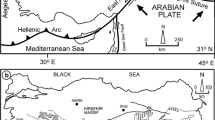Abstract
On cursory examination of hand specimens and thin sections, the abyssal tholeiite in a dredge haul may appear to be uniform in composition. Chemical analyses of a considerable number of fragments, however, have always revealed the existence of regular compositional variation in them. The MgO content decreases with increasing SiO2. In abyssal tholeiites with relatively low Al2O3 contents, the SiO2, total iron, Na2O and P2O5 contents tend to increase and the MgO content tends to decrease with increasing iron/magnesia ratio, probably owing to crystallization differentiation.
In a certain dredge haul, high-alumina abyssal tholeiites (with Al2O3 contents near or over 17%) occur in association with low-alumina abyssal tholeiites. The magma of high-alumina abyssal tholeiites would be generated from that of low-alumina abyssal tholeiites by differentiation at a depth around 30 km.
In pillow lavas of abyssal tholeiite free from weathering and metamorphism, the chilled rim of the pillow usually has virtually the same chemical composition as the more crystalline core except for a decrease of K2O content toward the rim. On the other hand, the weathered rim of pillow lavas shows marked compositional change. The Fe2O3/FeO ratio of unweathered abyssal tholeiite is in the range of 0.1 to 0.3. This ratio and the H2O− and H2O+ contents increase with advancing weathering.
Similar content being viewed by others
References
Aumento, F.: Magmatic evolution on the Mid-Atlantic Ridge. Earth and Planetary Sci. Letters 2, 225–230 (1967).
—: The Mid-Atlantic Ridge near 45° N. II. Basalts from the area of Confederation Peak. Canad. J. Earth Sci. 5, 1–21 (1968).
Engel, A. E. J., and C. G. Engel: Composition of basalts from the Mid-Atlantic Ridge. Science 144, 1330–1333 (1964a).
—: Igneous rocks of the East Pacific Rise. Science 146, 477–485 (1964b).
—, C. G. Engel, and R. G. Havens: Chemical characteristics of oceanic basalts and the upper mantle. Geol. Soc. Am. Bull. 76, 719–734 (1965).
Engel, C. G., R. L. Fischer, and A. E. J. Engel: Igneous rocks of the Indian Ocean floor. Science 150, 605–610 (1965).
Frey, F. A., M. A. Haskin, J. A. Poetz, and L. A. Haskin: Rare earth abundances in some basic rocks. J. Geophys. Res. 73, 6085–6098 (1968).
Gast, P. W.: Terrestrial ratio of potassium to rubidium and the composition of Earth's mantle. Science 147, 858–860 (1965).
—: Trace element fractionation and the origin of tholeiitic and alkaline magma types. Geochim. Cosmochim. Acta 32, 1057–1086 (1968).
Green, D. H., and A. E. Ringwood: The genesis of basaltic magmas. Contr. Mineral. and Petrol. 15, 103–190 (1967).
Haskin, L. A., F. A. Frey, R. A. Schmitt, and R. H. Smith: Meteoritic, solar and terrestrial rare-earth distributions. Phys. Chem. Earth 7, 167–321 (1966).
Heezen, B. C., M. Tharp, and M. Ewtng: The floors of the oceans. I. The North Atlantic. Geol. Soc. Am. Spec. Paper 65 (1959).
Kuno, H.: High-alumina basalt. J. Petrol. 1, 121–145 (1960).
—: Lateral variation of basalt magma type across continental margins and island arcs. Bull. Volcanol. 29, 195–222 (1966).
Melson, W. G., E. Jarosewich, R. Cifelli, and G. Thompson: Alkali olivine basalt dredged near St. Paul's Rocks, Mid-Atlantic Ridge. Nature 215, 381–382 (1967).
—, G. Thompson, and T. H. Van Andel: Volcanism and metamorphism in the Mid-Atlantic Ridge, 22° N latitude. J. Geophys. Res. 73, 5925–5941 (1968).
Miyashiro, A., F. Shido, and M. Ewing: Petrologic models for the Mid-Atlantic Ridge. Deep-Sea Res. in press (1969).
Moore, J. G.: Petrology of deep sea basalt near Hawaii. Am. J. Sci. 263, 40–52 (1965).
Muir, I. D., and C. E. Tilley: Basalts from the northern part of the rift zone of the MidAtlantic Ridge. J. Petrol. 5, 409–434 (1964).
—: Basalts from the northern part of the Mid-Atlantic Ridge. II. The Atlantis collections near 30° N. J. Petrol. 7, 193–201 (1966).
Nicholls, G. D.: Basalts from the deep ocean floor. Mineral. Mag. 34 (Tilley vol.), 373–388 (1965).
Powers, H. A.: Composition and origin of basaltic magma of the Hawaiian Islands. Geochim. Cosmochim. Acta 7, 77–107 (1955).
Yoder, H. S., and C. E. Tilley: Origin of basaltic magmas: an experimental study of natural and synthetic rock systems. J. Petrol. 3, 342–532 (1962).
Author information
Authors and Affiliations
Additional information
Lamont-Doherty Geological Observatory Contribution No. 1339
Rights and permissions
About this article
Cite this article
Miyashiro, A., Shido, F. & Ewing, M. Diversity and origin of abyssal tholeiite from the Mid-Atlantic Ridge near 24° and 30° North latitude. Contr. Mineral. and Petrol. 23, 38–52 (1969). https://doi.org/10.1007/BF00371331
Received:
Issue Date:
DOI: https://doi.org/10.1007/BF00371331




